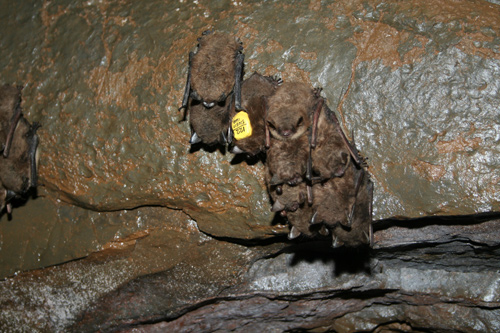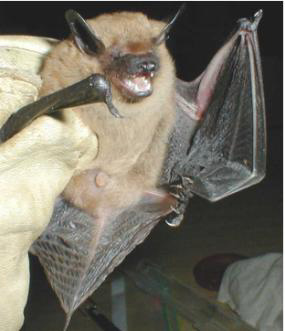The Little Brown Bat and the Big Brown Bat have been the two most common bats in Connecticut. Both have brown-furred bodies. The forelegs and "hands" of bats have become wings. The wing membranes stretch between the elongated "fingers". The "thumb" exists as a little claw at the end of the forearm. Bats use this claw to climb and crawl when not in flight. Bats roost by hanging upside-down from their rear foot claws.
The Little Brown Bat weighs 1/8 to 1/2 oz. The body is 2 to 4 inches long and the wingspan is 9 to 11 inches.
The Big Brown Bat weighs 1/2 oz or a little more. The body is 6 to 7 inches long and the wingspan is 12 to 16 inches.
Both bats range through most of the continental US and into southern Canada. They can live in woods, farmfields, and cities and are the bats most often found roosting in houses in Connecticut. Brown bats are nocturnal (like other North American bats). They are active during the spring, summer and fall. During the day they roost in a dark, warm place such as an attic, hollow tree or cave. For both species the males tend to roost solo or in small groups during the summer months while the females will gather in communal nursery roosts with their pups. They hibernate in similar spaces during the winter. Little brown bats hibernate in clusters.
Both bats are insectivores. Bats don't eat that many mosquitoes because mosquitoes do not fly as high up as bats usually feed. Bats eat alot of beetles, many of them harmful garden pests. Insects are caught in the bat's mouth, or sometimes scooped up with the tail membrane. Bats must build up enough fat to survive their winter hibernation.
These bats mate in the fall. The female doesn't ovulate and fertilization doesn't occur until the bats come out of hibernation next spring. The young are born in June or July.
Little Brown Bats can fly as fast as 22 mph and Big Brown Bats can reach up to 40 mph. Neither bat is blind. Unlike common belief, bats are not without sight. However they do use echolocation to track prey and to navigate.
Like all mammals, bats can carry and transmit rabies, but very few bats have it. Treat them with the same caution given to any wild animal. Don't approach them or try to handle them but don't cower in fear either. Bats are not aggressive. They do not fly into the hair of humans. If you are outside when bats are feeding, they may be swooping and diving overhead, but they are after flying insects, not you. If you watch bats flying at dusk, their maneuvers are fascinating and graceful.
Other Connecticut BatsOther species of bats that can be found in Connecticut are the Eastern Longhaired Bat Myotis septentrionalis, the Eastern Pipistrelle Pipistrellus subflavus, the Silver-haired Bat Lasionycteris noctivagans, the Hoary Bat Lasiurus cinereus, the Red Bat Lasiurus borealis and the Indiana Bat Myotis sodalis.
Not So Neat Fact
Little Brown Bats and Big Brown Bats are in trouble. Large numbers of these bats (and bats of several more species) are dying of White-nose Syndrome all over the US. Bats with White-nose have a fungus that can be seen growing on their noses, ears, and wing membranes while they hibernate. It seems to mess up hibernation. Bats are running out of their reserves of fat before winter ends and starving to death. White-nose Syndrome was first discovered in 2006 and is not completely understood. The fungus, Geomyces destructans, grows in cold temperatures. There is speculation that the fungus is a non-native, possibly European, organism to which North American bats have little resistance. It appears to spread from bat to bat and could also be spread from colony to colony by humans who visit the areas where bats hibernate, such as cavers. The mortality rate is high, over 90%, and many long-term bat populations have been erradicated. As in many other areas, our Connecticut bats could be wiped out by this disease. This would be tragic, as not only are bats delightful, acrobatic fliers of the night, they are an important part of the ecosystem. They consume huge amounts of insects, and their loss would be keenly felt.

